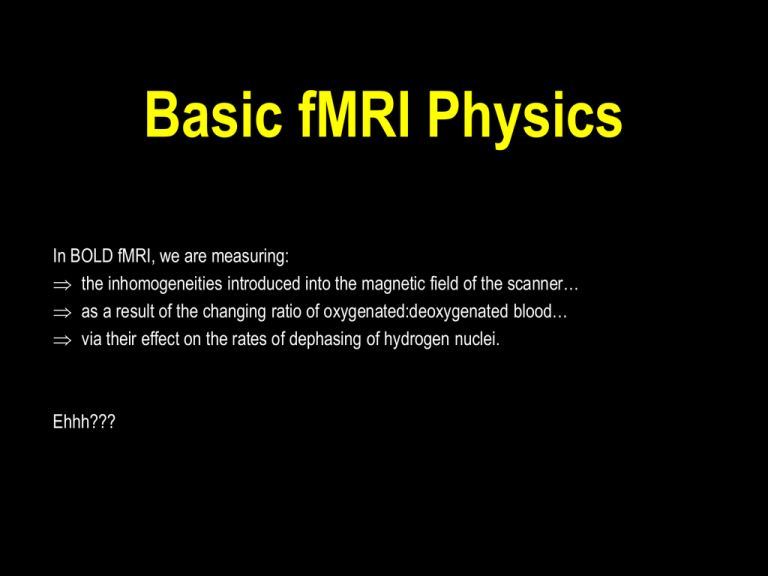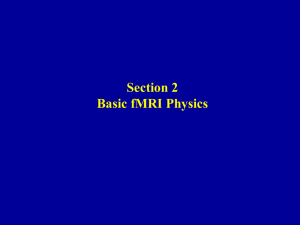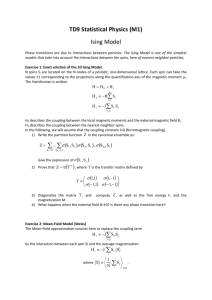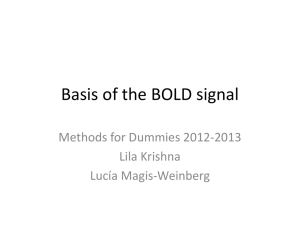BOLD signal
advertisement

Basic fMRI Physics In BOLD fMRI, we are measuring: the inhomogeneities introduced into the magnetic field of the scanner… as a result of the changing ratio of oxygenated:deoxygenated blood… via their effect on the rates of dephasing of hydrogen nuclei. Ehhh??? History of MRI NMR = nuclear magnetic resonance nuclear: properties of nuclei of atoms magnetic: magnetic field required resonance: magnetic field x radio frequency NMR MRI: Why the name change? 1946: Block and Purcell atomic nuclei absorb and re-emit radio frequency energy 1992: Ogawa and colleagues first functional images using BOLD signal Bloch Purcell Ogawa most likely explanation: nuclear has bad connotations less likely explanation: NMR means Nouveau Mouvement Religieux Necessary Equipment 3T magnet RF Coil gradient coil (inside) Magnet Gradient Coil RF Coil Source: Joe Gati, photos Recipe for MRI 1) Put subject in big magnetic field (leave him there) 2) Transmit radio waves into subject [about 3 ms] 3) Turn off radio wave transmitter 4) Receive radio waves re-transmitted by subject – Manipulate re-transmission with magnetic fields during this readout interval [10-100 ms] 5) Store measured radio wave data vs. time – Now go back to 2) to get some more data 6) Process raw data to reconstruct images 7) Allow subject to leave scanner (this is optional) Source: Robert Cox’s web slides The Big Magnet Main field = B0 • Continuously on • Very strong : Earth’s magnetic field = 0.5 Gauss / 1 Tesla (T) = 10,000 Gauss 3 Tesla = 3 x 10,000 0.5 = 60,000 x Earth’s magnetic field x 60,000 = Source: www.spacedaily.com B0 Robarts Research Institute 3T Safety The strength of the magnet makes safety essential : things fly – even big things! Source: www.howstuffworks.com Source: http://www.simplyphysics.com/flying_objects.html Anyone entering the magnet must be metal free This subject was wearing a hair band with a ~2 mm copper clamp. Left: with hair band. Right: without. Source: Jorge Jovicich Develop screening strategies : do the metal macarena! 1H aligns with B0 Protons are abundant: high concentration in human body have high sensitivity: yields large signals Outside magnetic field • randomly oriented longitudinal axis transverse plane M=0 Inside magnetic field Longitudinal magnetization • spins tend to align parallel or anti-parallel to B0 • net magnetization (M) along B0 • spins precess with random phase • no net magnetization in transverse plane • only 0.0003% of protons/T align with field M Source: Mark Cohen’s web slides Source: Robert Cox’s web slides Larmor equation : resonance frequency f = B0/2π for 1H = 42.58 MHz/T Frequency (MHz) Larmor Frequency 127.7 63.8 1.5 3.0 Field Strength (Tesla) Turn your dial to 3T fMRI … … broadcasting at a frequency of 127.7 Mhz Radio-Frequency Excitation • transmission coil: apply magnetic field along B1 (perpendicular to B0 for ~3 ms) • oscillating field at Larmor frequency • frequencies in range of radio transmissions • B1 is small: ~1/10,000 T • tips M to transverse plane – spirals down • analogies: guitar string (Noll), swing (Cox) • final angle between B0 and B1 is the flip angle longitudinal axis Transverse magnetization Source: Robert Cox’s web slides Relaxation and Receiving Receive Radio Frequency Field • receiving coil: measure net magnetization (M) • readout interval (~10-100 ms) • relaxation: after RF field turned on and off, magnetization returns to normal longitudinal magnetization T1 signal recovers (realignment) transverse magnetization T2 signal decays (dephasing) Source: Robert Cox’s web slides Why the dephasing ? • protons precess at slightly different frequencies because of (1) random fluctuations in the local field at the molecular level that affect both T2 and T2*; (2) larger scale variations in the magnetic field that affect T2* only. • over time, the frequency differences lead to different phases between the molecules (clock analogy) • as the protons get out of phase, the transverse magnetization decays • this decay occurs at different rates in different tissues Source: Mark Cohen’s web slides T1 and TR T1 = recovery of longitudinal magnetization (B0) due to realignment of spins TR (time to repetition) = time to wait after excitation before sampling T1 = time before next RF excitation ≈ M0(1-exp(-t/T1)) Source: Mark Cohen’s web slides T2 and TE T2 = decay of transverse (B1) magnetization due to dephasing of spins TE (time to echo) = time to wait before sampling T2 (after refocusing of signal) ≈ exp(-t/T2)) Source: Mark Cohen’s web slides T1 and T2 contrasts TISSUE T1(s) T2(s) grey matter 1.0 0.10 white matter 0.7 0.08 CSF 2.0 0.25 blood 1.2 0.25 water 4.7 3.50 Source: Mark Cohen’s web slides T2* relaxation • dephasing of transverse magnetization due to both: - microscopic molecular interactions (as for T2) - spatial variations of the external main field B (tissue/air, tissue/bone interfaces) • exponential decay (T2* 30 - 100 ms, shorter for higher Bo) Mxy Mo sin T2 T2 * time Source: Jorge Jovicich Spatial Coding: Gradients Frequency How can we encode spatial position? • Add a gradient to the main magnetic field • Excite only frequencies corresponding to slice plane • Use other tricks to get other two dimensions left-right: frequency encode top-bottom: phase encode Field Strength ~ z position Gradient switching – that’s what makes all the beeping & buzzing noises during imaging => EAR PLUGS ! Echos pulse sequence: series of excitations, gradient triggers and readouts Echos = refocusing of signal Spin echo (not shown) – measure T2 (left-right) Gradient echo (shown) - measure T2* flip the gradient at t=TE/2 measure after refocusing at t=TE (top-bottom) t = TE/2 A gradient reversal at this point will lead to a recovery of transverse magnetization TE = time to wait to measure refocused spins Source: Mark Cohen’s web slides A walk through the K-space (inverse Fourier transform) Source: Traveler’s Guide to K-space (C.A. Mistretta) Susceptibility Adding a nonuniform object (like a person) to B0 will make the total magnetic field nonuniform This is due to susceptibility: generation of extra magnetic fields in materials that are immersed in an external field Susceptibility Artifact - occurs near junctions between air and tissue sinuses, ear canals - spins become dephased so quickly (quick T2*), no signal can be measured sinuses Source: Robert Cox’s web slides ear canals Susceptibility variations can also be seen around blood vessels where deoxyhemoglobin affects T2* in nearby tissue Hemoglobin A molecule to breathe with: - four globin chains - each globin chain contains a heme group - at center of each heme group is an iron atom (Fe) - each iron ion Fe2+ can attach an oxygen molecule (O2) - oxy-Hemoglobin (four O2) is diamagnetic no B effects - deoxy-Hemoglobin is paramagnetic if [deoxy-Hgb] local B Source: http://wsrv.clas.virginia.edu/~rjh9u/hemoglob.html, Jorge Jovicich BOLD signal Blood Oxygen Level Dependent signal neural activity blood flow oxyhemoglobin T2* MR signal Mxy Signal Mo sin T2* task T2* control Stask Scontrol S TEoptimum Source: Brief Introduction to fMRI by Irene Tracey time Source: Jorge Jovicich BOLD signal Source: Doug Noll’s primer To take away Magnetic field Tissue protons align with magnetic field (equilibrium state) RF pulses Kwong et al., 1992 Relaxation processes Protons absorb RF energy (excited state) Spatial encoding using magnetic field gradients Relaxation processes Protons emit RF energy (return to equilibrium state) NMR signal detection Repeat RAW DATA MATRIX Fourier transform IMAGE Source: Jorge Jovicich





